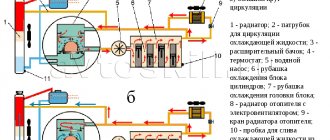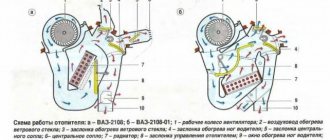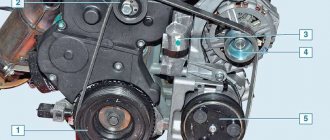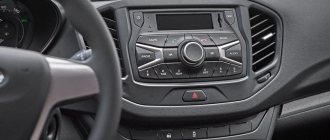The need to properly warm up the car
It often seems to car owners that warming up the car only means increasing the air temperature in the cabin, thereby ensuring driving comfort. However, first of all, it will be necessary to ensure heating of the technical fluid in the engine and gearbox, which will directly determine the absence of premature engine wear. If you hit the road with a cold engine, the oil will not provide the necessary lubrication of the engine, increased wear will be observed, and by 100-150 thousand kilometers such an engine will require major repairs or replacement.
You should also remember the concept of thermal deformation of metal at subzero temperatures. This leads to improper operation of the valves and piston group. As a result, the car begins to consume more fuel, the cylinders wear out, valve failures may occur, and, not uncommonly, the crankshaft jams, after which a major overhaul of the car is required. Such breakdowns can only be prevented by properly warming up the engine, the technology of which will differ depending on the presence or absence of auto start and an autonomous heater.
Autonomous stove hair dryer
What is a turbocharger on a car, its history of creation and operating principle. What is a turbocharger?
The device is designed to quickly heat the air in the vehicle interior.
The device consists of:
- electromagnetic fuel pump;
- electronic control unit;
- glow plugs;
- heat exchanger with combustion chamber;
- electric motor with impeller;
- temperature sensors at the flow inlet, in a given place in the cabin and an overheating sensor;
- housings.
How the hair dryer works
An electromagnetic fuel pump, controlled by an electronic unit, supplies fuel from a standard or separately installed gas tank to the combustion chamber of the heater. The glow plug ignites the mixture. The flame heats the heat exchanger surrounding the combustion chamber. Cold air supplied by a fan into the space between the device body and the heat exchanger is heated to a predetermined temperature and flows back into the cabin.
Combustion products are discharged through pipes outside the vehicle. Signals from the sensors are sent to the control unit, which regulates the fuel supply, depending on their readings. From the control panel you can set temperature parameters and operating duration. The heater is powered by a standard battery. In some cases, a separate heater battery is installed.
Pros of the system
- High efficiency (fuel consumption from 0.1 liters/hour)
- Ease of installation (installed anywhere inside the car)
- Selecting a program of operating modes.
- Efficient interior heating.
Minuses
- Does not affect engine temperature.
- Drains the battery.
An autonomous heater and engine pre-heating system make operating the car more comfortable, help overcome the difficulties of a long winter, and extend the service life of the engine.
An air-heating stove creates additional convenience during long-term parking, both in frost and in temperate climates. The engine pre-heating system is most effective in frosty winter conditions. The additional costs associated with the purchase and installation of equipment pay off with interest, because not only the ease of use of the car, but also the life of the driver depends on it.
Algorithm for proper engine warming up
Car owners often make a common mistake: after parking the car for a long time, they start the engine and then turn on the heater to maximum, which, in their opinion, should heat up not only the engine, but also the air in the cabin. However, in reality, in such a case, the load on the engine increases significantly, which reaches the minimum temperature regime for a long time.
The speed of warming up the engine and the interior are interconnected. At the same time, you need to understand that it is possible to ensure the flow of warm air into the cabin only when the engine is hot. Effective heating of the engine and interior is possible only when the coolant warms up to the required levels, after which hot antifreeze is supplied to the heater radiator, which allows you to quickly heat the interior of the car.
Modern cars can be equipped with several heating systems, programmable electronic climate, as well as one, two or three-zone heaters. Often car owners do not read the instructions for their car, which detail how to use such heating, how to properly warm up the car and how long this procedure takes on average.
According to statistics, in winter, when the outside temperature is minus 10 degrees, heating the engine usually takes 15 minutes, and it takes 30-35 minutes to raise the temperature in the cabin. Whereas in winter we often warm up the car for at most 5 minutes, which is spent on cleaning the windows from ice. After which the car owner sets off on a virtually cold engine, which leads not only to increased fuel consumption, but also to serious wear and critical breakdowns of the power unit.
To properly warm up the engine of a car, you need to set the heater fan intensity switch to minimum, then start the engine and leave the car running for at least 10 minutes. With the heating circuit closed, the engine quickly heats up; as soon as the coolant temperature begins to rise, you can start driving the car, simultaneously turning on the heater and heating the interior of the car itself. If your car is equipped with a W ebasto heater or autostart, you can immediately turn on the heater at maximum power, quickly warming up the car interior.
Let's sum it up
In winter, it is extremely important to properly warm up the car, which not only reduces fuel consumption, but also prevents increased wear and critical engine malfunctions. With such a mileage, you will need to start the engine, setting the heater control to minimum efficiency, or completely turn off the interior heating. This will allow you to warm up the engine faster, only after this you can turn on the interior airflow, and warm heated air will immediately begin flowing from the air ducts.
How to quickly warm up a car interior in winter with a standard heating system
The procedure for heating a car interior in winter with a basic stove does not take much time, the main thing is to know how to do it correctly. It happens that even car owners with many years of experience do not know how to properly use the stove in winter.
The easiest way for owners of cars with a climate control system is that, with proper configuration, the system will independently heat the temperature inside the car to the optimal temperature.
How to properly warm up the car interior:
- Before starting the engine and starting to warm up the interior, it needs to be thoroughly ventilated to equalize the humidity level inside and outside the cabin. It is enough to open the doors for 1-2 minutes.
- Turn on the “ air recirculation ” mode. This will close the ventilation slots, which will prevent icy air from entering from the street. In this case, the heating system will not take air from outside, but will use warm air from the cabin, constantly passing it through the radiator and warming it up more and more. This way the interior will be heated much faster. It must be remembered that if there is at least one person in the cabin, the windows will fog up very quickly. Because a person exhales moist air.
- Turn on the stove at about 1-2 speed . There is no point in setting it to full power at the initial stage, because... The coolant will not be heated and the radiator will also be cold. It is necessary to increase the power as the interior heats up. It makes sense to set full power only after 10 minutes of warming up the interior.
- Set the maximum air temperature.
- When the windows fog up, you need to set the mode “ from glass to feet ”. Standard mode, which is provided on all cars.
- After 6-7 minutes, you can switch to the “ center - feet ” mode. At about the 10th minute, when the cabin becomes comfortable enough, you can start driving. By the 15th minute the air temperature will be optimal. However, do not forget to switch modes without allowing the glass to fog up.
- When the interior has warmed up to the optimal temperature, you need to turn off the “air recirculation” mode and continue heating the interior in the usual way.
How to turn on the heater in your car in winter? Tricky life hacks
Quite often people wonder how to properly turn on the heater in a car in winter. After all, at sub-zero temperatures, an unheated cabin is very uncomfortable, and under certain conditions this can lead to health problems. If you use the heater incorrectly, you can get completely different problems, which is also not very good. Please note
that warming up the interior should be considered only in conjunction with other actions to bring the car into working condition. Using the stove correctly, you will increase the level of comfort in the cabin.
How to turn on the heater in your car in winter? Knowing the answer to this question will allow you to prevent many problems. Most often, if the heater is turned on incorrectly, the windshield cracks. Probably everyone has seen long cracks along the deflectors on the torpedo, the reason for this is the incorrectly selected operating mode. Also among the consequences of incorrectly switching on the heater is uneven heating of the interior.
. Sometimes, a problem may arise with the performance of the stove. Therefore, it makes sense to study all the main nuances.
How to turn it on?
The first mistake that drivers make is starting the engine with the heater on. This can lead to two problems at once:
- Car owners who use autostart often sin like this. They like to come straight to a warm salon, but the possible disadvantages outweigh all the positive aspects. You should not start the engine with the heater on unless you want to get it repaired, which is not very pleasant in winter.
- The next point, which is also a mistake, is that the stove is turned on immediately after starting the engine. Especially if it’s a serious minus outside. There are several reasons to consider such actions simply useless:
- Only the running engine has not yet gained momentum, and is unable to support the operation of powerful energy consumers. Therefore, you can often observe that when you turn on the stove within the first 10 seconds after starting, the motor begins to wither;
- Heating occurs by heat transfer from antifreeze located in the cooling system. Immediately after starting the engine, it is cold, so heating is of no use. Also, do not forget that at first the coolant circulates in a small circle, that is, around the engine. As a result, a heater turned on until the engine has warmed up to operating temperature is simply useless.
Never rush
with the stove turned on. Let the engine warm up, after which you will be able to get optimal results much faster. Also remember that the battery discharges during startup, so allow it to regain its capacity.
Another mistake
can be called incorrect use of operating modes. Often drivers, in order to speed up the heating of the cabin, immediately turn on the highest possible mode. This is where the problem arises. Too fast air supply does not speed up the heating of the cabin, and due to uneven heat distribution, uncomfortable zones arise. This is fraught with the risk of getting sick, because your legs and head will be cold, and your body, on the contrary, will be in the heat.
It is important to use the deflector system correctly. The best option would be to direct the heat to your feet
. After waiting a couple of minutes, you need to distribute the warm air between your feet and the windshield. This will give the best result and will avoid cracks on the windshield. Another thing to consider is the speed of the stove. You should not turn on the maximum mode immediately after starting a cold stove. Start with speed 1 and gradually increase the speed.
Climate control features
Now, more and more cars have this option. So let's see how it works in winter. Be sure to set the climate control. Otherwise there will be no sense from it. Choose the optimal temperature that suits you completely. As a rule, this element has additional keys for controlling mechanical components. We are interested in the “ recirculation in the cabin”
", sometimes it may be called differently, but its meaning remains to block access to outside air into the cabin. This will significantly speed up the heating process inside. If the car is working properly, the process will calmly take place automatically. Pay attention to his work. The intensity of the heater is constantly increasing, this must be taken into account when warming up the interior in manual mode.
Additional devices
To achieve greater comfort, many cars are equipped with heated seats. This allows you to avoid freezing to the seat even in an unheated cabin. You can turn it on immediately after starting the engine. This will ensure a sufficient level of comfort. Sometimes, drivers install an additional heater in the cabin. It can operate either from a small engine installed in the engine compartment or from the mains. It makes sense to install such a device if there is a need for long-term parking in winter with the driver in the cabin. Taxi drivers and truck drivers often use such solutions.
Conclusion
. The heater in a car is an important element that allows you to use the vehicle safely and comfortably. Therefore, the question of how to properly turn on the heater in a car in winter arises. Indeed, in this seemingly simple question there are a large number of nuances. Only careful adherence to them will avoid problems, as well as maintain the health of the driver and passengers in order.
Types of additional heating device
If the owner of a Russian vehicle is thinking about how to install an additional heater on a VAZ-2110, then, first of all, he should know that the practical majority of currently existing designs fit directly into the standard cooling system of the power unit.
The heated air flow is distributed throughout the cabin by a built-in electric fan. Additional stove purchased at the store
An additional stove for the interior of the VAZ-2110 can be purchased at the store, however, in order to save money, such a unit can be made with your own hands. In fact, car dealerships sell completely different types of additional heaters. Depending on the budget and preferences of the motorist, you can choose both small and fairly large designs. True, not all presented models can be placed in the top ten without compromising passenger comfort. There is not much free space in a domestically produced car, so when choosing a unit, you should first decide on the location of its future installation.
If the car owner decides to install an additional heater under the passenger seat, then the purchased device should not be wider than 33 cm, higher than 20 cm and have a depth not exceeding 25 cm.
If you choose the optimal location for an additional heater, you should stop in the area of the car located between the seats (the unit will take the place of the tunnel), or directly under the front passenger seat.
In view of all the above conditions, the homemade additional heater VAZ-2110 must be an autonomous compact unit. Among the most popular models, it is worth noting the products of the TechnoMaster company, produced in Tolyatti. The cost of such a device ranges from 2500–3000 rubles. The products Helios, Xeros and Zenith, owned by the Eberspächer company, are of good quality. Their cost may be only a few hundred higher than the previously indicated models.
We recommend: What to do if the engine overheats?
If the car owner decides not to waste time and not to upgrade the standard VAZ-2110 stove, but to place a new additional device in the cabin, when choosing a design, you should carefully study the characteristics and dimensions of the additional device.
Class inequality
Let's look at two extremely different cars and use their example to see how much warmer it can be in a modern car than in its ancestor thirty years ago and why.
As the first option, let's take an old car - like the "forty-one" Moskvich with its famous aluminum engine. Its arsenal includes a massive, slow-warming carburetor engine, a not very efficient heater and a cracked body. The volume of the body, by the way, is quite large and it takes a long time to warm it up. We have not heard of any additional means of heating the driver and passengers. Perhaps an electrically heated seat cover.
The second option is a modern compact crossover with a relatively powerful naturally aspirated engine and all sorts of pleasant “warm” options. Compact - therefore, the interior volume is not that large, although in fairness, it must be said that in a sedan of the same class it is even slightly smaller. Why crossover? Yes, because on such a compact machine the engine has to rotate a bunch of gearboxes and transmission shafts under the bottom. At the same time, lubricants and oils thicken due to frost. All this puts more load on the engine and, accordingly, speeds up its warming up.
Let's move on. A naturally aspirated gasoline engine warms up faster than a diesel or supercharged gasoline engine. “Warm” options - such as heated seats, steering wheel and windshield - are not only useful and pleasant for those inside the car, but also speed up engine warm-up, since they put a decent load on it through the generator. The load on the on-board electrical network is maximum, the generator is working hard, taking power from the engine, and in response, it warms up faster. Some modern cars also have a standard electric heater for the air passing through the heater into the cabin. This function is extremely useful in winter.
How to heat?
Now let's figure out how to use the heater in a car. The most important thing, and not only in winter, is to guarantee traffic safety.
So, you approach a car covered in snow and completely frozen since yesterday evening. First of all, you should clean the gap between the driver's door and the body, otherwise snow will get on the seat. He will literally be sucked inside when you start to open the door. Next, you should start the engine and immediately turn on the air flow from the heater to the windshield, setting the maximum temperature. At the same time, you should not be afraid of classic winter glass cracks. After all, the windshield will warm up quite slowly along with the engine. And only if you have a car with an electric heater built into the heater, you should not select the maximum temperature on the control unit.
But if the car has electric glass heating, then you need to turn it on immediately and at full power. The main thing, I implore you, is not to start driving with half-cleaned glass. Especially in sunny weather, when the ice on the glass plays with thousands of small “diamonds,” literally blinding the driver. In a word, clean the glass with a scraper, special aerosol defrosters, warm “anti-freeze” brought from home... But from a place with opaque glass - no, no.
So, we wait until the windshield is cleared and only then do we start moving. At the same time, the engine continues to warm up, and its heat should be enough to uniformly heat the entire interior of the car. You can direct some of the heated air down to your feet. It is useful to do this not only to prevent the lower extremities from freezing, but also to dry the car mats, on which in winter the snow-water porridge takes up more and more volume. And wet carpets mean fogging up the windows, and generally a nasty atmosphere in the car interior.
On vehicles that have manual heater fan speed control, there is no point in using a speed higher than second when warming up in winter. The air will not have time to heat up when passing through the heat exchanger of the heater. There will be a lot of noise and a draft, but the air enters the cabin barely warmed up. In addition, this mode will slow down the warming up of the engine, which is harmful both for it and for the microclimate in the cabin. Until a modern engine with a fuel injection system warms up, its crankshaft speed will be slightly increased, reaching 1500 -1800 rpm. Then the speed will begin to decrease on its own, down to idle. And if we are forced to wait for the windshield to defrost while sitting in the cabin, then it is useful to maintain a slightly increased engine speed, but not more than 2000 rpm. However, if you are parked in the courtyard of a residential building, then you should not smoke again. It’s better to drive slowly, even at the lowest speed. And the engine will warm up faster, and heat will enter the cabin earlier, and you won’t cause any discomfort to your neighbors.
Turning on the air conditioner at sub-zero temperatures is not advisable. However, the car itself will not let you turn it on. In this case, the air conditioner operation indicator (A/C button) may be on, but in reality, at negative temperatures, the electronics will not allow the air conditioning compressor to turn on in order to avoid its breakdown.
The correct microclimate in the cabin - how to set it?
“Stove”, “condo”, “climate”, these incomprehensible “knobs” and buttons in the cabin - many drivers, not bothering to read the instructions, often use them for other purposes. It is especially difficult for beginners - even if they have studied the “manual”, they often do not have sufficient experience. That’s why we decided to briefly tell you how to maintain the correct microclimate in your car.
Do your windows sweat in damp and cold weather? Turn on the air conditioner and direct the air flow to the windshield.
We provide an overview
In damp and cold weather, the car windows often begin to sweat, especially if there are many passengers inside. Of course, this situation threatens that at some point you will no longer see through them. If there is an air conditioner, then just press the AC button (A/C or with the snowflake icon “*”), transfer the airflow to the windows and wait a little. The air will become much drier and condensation will disappear from the glass. Sometimes it happens that too cold air inside provokes perspiration on the outside of the windshield - it is enough to wipe it off with the windshield wipers.
Finally, the simplest defogging option is available to owners of cars with climate control - there is a button for blowing the windows as quickly as possible. And do not forget to regularly change the cabin filter - often the problem of fogging lies there.
Changing the cabin filter regularly is the key to keeping your windows clean and the air inside your car fresh.
In winter, another problem arises - frost and even ice appears on the glass (for example, if there is freezing rain or the snow melts and freezes again). If the car does not have an electrically heated windshield and an electric heater, then you will have to wait until the engine warms up a little - you should not immediately move the temperature regulator to the red zone, this will not only not help the matter, but will even worsen it, because the engine will give off all the heat to the cabin and warm up will slow down.
In winter, there is no point in immediately turning the heater on full blast if you do not have an electric heater or additional heater installed - the fan will drive icy air around the cabin. Allow the engine to warm up so that it can produce enough heat.
We need to wait a little. As soon as the engine warms up, you can safely control the valves and increase the fan speed (the climate control automatically does this on its own). Don’t forget to use heated mirrors (if available), and it will help not only in case of icing, but also dry up drops during rain.
Use the heated mirrors and rear window during rain or snowfall.
We provide comfort
The first thing to avoid in the heat is sudden temperature changes. For example, if it is more than 30 degrees Celsius outside, then it is not recommended to immediately set 18 degrees on the climate control unit. Allow your body to adapt a little and lower the temperature gradually . The same applies to a regular air conditioner - do not immediately turn the knob to minimum. Otherwise, the risk of respiratory tract diseases increases.
In the heat, when getting into the car “soaped”, do not allow a sharp temperature change, do not immediately turn the temperature control knob to minimum.
By the way, in the heat, before starting to drive, you need to open all the doors or windows so that the hot air can quickly escape from the cabin, and when operating in a hot climate, you should choose light-colored cars - they heat up much less. In winter, you should not arrange a “sauna” in the car - a steamed body is unlikely to be happy with the frost outside. If you feel hot inside even with the standard 21-22 degrees on the climate control screen or with the air conditioner temperature knob in the middle position, then you need to take off your outerwear - this will also make driving easier. And remember that the most important thing is to keep your feet warm - cold feet will feel the pedals worse.
In hot weather, it is better to first ventilate the interior by opening windows and doors so that the hot air escapes faster.
Modern cars are usually equipped with heated/ventilated seats and steering wheels. And if there are no special features with the steering wheel, then you should be more careful with the “fifth point” - do not allow hypothermia or overheating, fortunately, many cars have step adjustment. If these options are available for a reasonable surcharge, don’t skimp, owning a car in winter will become much more comfortable.
If you feel hot at the standard 21-22°C inside the car, even with the air conditioning on and at medium fan speed, then remove outer clothing if possible.
Getting rid of unpleasant odors
You turned on the air conditioning and the cabin smelled like swamp or rotten air? This means that bacteria and pathogenic fungi multiply in the ventilation system. This does not bode well (in some cases it can even cause allergic reactions), so disinfection must be carried out. It is best, of course, to do this at a specialized service (they have equipment that allows you to completely get rid of unpleasant odors), but you can save money and carry out the treatment yourself by buying an aerosol can (about 500 to 1000 rubles).
The most basic way to clean the ventilation system from rotten smells and pathogenic bacteria is to buy a can of air conditioner cleaner and treat all the deflectors, as well as the drainage hole.
Air recirculation - turn on or not?
If your task is solely to heat the interior as quickly as possible, then turning on recirculation can slightly speed up this process. But then you will have to solve another problem - foggy windows. The fact is that the car is always very wet from the snow on the floor mats and on the clothes of the driver and passengers. Breathing, especially from several people, also greatly humidifies the air in the cabin. You can use recirculation for a short time while driving, when the car interior is well warmed up, has dried out a little, and a smoky KAMAZ is driving in front of you on the road. The recirculation mode is turned on if you need to talk to a passenger in a parked car for some time, and it is very cold outside. In this case, recirculation should be combined with the heater turned on at maximum temperature, because the idling engine weakly pumps liquid through the heater.
How to make a car heater with your own hands and power it from the cigarette lighter: instructions
The operating principle of fan heaters is based on the formation of a heat flow by blowing a heated body. The air flow is generated by a fan, and a ceramic heating element acts as a heat source. Previously, there were models with tubular electric heaters and nichrome spirals.
Selection of components
You can create additional heating for the car interior in winter using improvised means. One of the simple schemes includes components available to any inventor:
Autostart and autonomous heaters
The devices are diverse from a technical point of view, but, in essence, allow you to warm up the car without the participation of the owner. Therefore, the speed of the heating process itself does not play a special role. However, there is another, legal nuance. Environmental requirements in residential areas are becoming more stringent. As follows from the Traffic Rules, parking with the engine running in a residential area is prohibited. This means that more than 5 minutes is impossible. In other words, a car in a yard with an engine running for a longer period of time is illegal.
So, autonomous heaters, no matter how imported or branded they are, are the same internal combustion units. That is, they also burn oxygen and combine it with carbon and at the same time poison the air. The time is not far off when a good neighbor from his smartphone will send a slander to the right place - be it for the “autonomy” or for autostart. Therefore, I personally do not contact either one or the other device.
Do you have your own opinion? Share in the comments.
Autonomous interior heater
A much more effective way to quickly warm up the air in the cabin is to install a heater that can operate without the engine.
Autonomous heaters are in demand, first of all, among drivers who often have to spend the night in the car (truck drivers, tourists, travelers), because sleeping with the engine running, especially if it is diesel, is an unsafe activity. The main function of such devices is to heat the interior, which can be carried out both before starting the power unit and directly while driving.
An autonomous heater will not only help warm up the interior faster, but also save fuel and not waste battery power. On average, modern heaters consume 200 ml of fuel per hour, that is, for a whole night of continuous operation, consumption will not exceed 2 liters (for example, when idling, a 3.0-liter diesel engine will burn about 9 liters in the same time). Having a compact size, such a device is located directly in the cabin without taking up much space.











